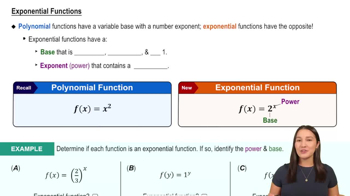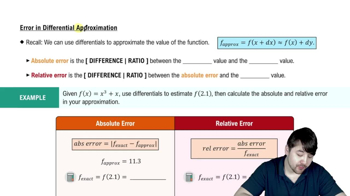Table of contents
- 0. Functions7h 52m
- Introduction to Functions16m
- Piecewise Functions10m
- Properties of Functions9m
- Common Functions1h 8m
- Transformations5m
- Combining Functions27m
- Exponent rules32m
- Exponential Functions28m
- Logarithmic Functions24m
- Properties of Logarithms34m
- Exponential & Logarithmic Equations35m
- Introduction to Trigonometric Functions38m
- Graphs of Trigonometric Functions44m
- Trigonometric Identities47m
- Inverse Trigonometric Functions48m
- 1. Limits and Continuity2h 2m
- 2. Intro to Derivatives1h 33m
- 3. Techniques of Differentiation3h 18m
- 4. Applications of Derivatives2h 38m
- 5. Graphical Applications of Derivatives6h 2m
- 6. Derivatives of Inverse, Exponential, & Logarithmic Functions2h 37m
- 7. Antiderivatives & Indefinite Integrals1h 26m
- 8. Definite Integrals4h 44m
- 9. Graphical Applications of Integrals2h 27m
- 10. Physics Applications of Integrals 2h 22m
4. Applications of Derivatives
Differentials
Problem 4.R.89
Textbook Question
82–89. Comparing growth rates Determine which of the two functions grows faster, or state that they have comparable growth rates.
2ˣ and 4ˣ⸍²
 Verified step by step guidance
Verified step by step guidance1
Step 1: Understand the problem by identifying the two functions given: \( f(x) = 2^x \) and \( g(x) = 4^{x^{1/2}} \). We need to determine which function grows faster as \( x \to \infty \).
Step 2: Simplify the second function \( g(x) = 4^{x^{1/2}} \). Notice that \( 4^{x^{1/2}} = (2^2)^{x^{1/2}} = 2^{2x^{1/2}} \). This means \( g(x) = 2^{2\sqrt{x}} \).
Step 3: Compare the exponents of the base 2 in both functions. For \( f(x) = 2^x \), the exponent is \( x \). For \( g(x) = 2^{2\sqrt{x}} \), the exponent is \( 2\sqrt{x} \).
Step 4: Analyze the growth of the exponents as \( x \to \infty \). The exponent \( x \) in \( f(x) \) grows linearly, while the exponent \( 2\sqrt{x} \) in \( g(x) \) grows as the square root of \( x \), which is slower than linear growth.
Step 5: Conclude that \( f(x) = 2^x \) grows faster than \( g(x) = 4^{x^{1/2}} \) as \( x \to \infty \), because the linear growth of \( x \) in the exponent of \( f(x) \) outpaces the square root growth of \( 2\sqrt{x} \) in the exponent of \( g(x) \).
 Verified video answer for a similar problem:
Verified video answer for a similar problem:This video solution was recommended by our tutors as helpful for the problem above
Video duration:
2mPlay a video:
Was this helpful?
Key Concepts
Here are the essential concepts you must grasp in order to answer the question correctly.
Exponential Functions
Exponential functions are mathematical expressions of the form f(x) = a * b^x, where 'a' is a constant, 'b' is the base, and 'x' is the exponent. These functions grow rapidly as 'x' increases, and their growth rate is determined by the base 'b'. In this question, the functions 2^x and 4^x are both exponential, but they have different bases, which affects their growth rates.
Recommended video:

Exponential Functions
Growth Rate Comparison
To compare the growth rates of two functions, we often analyze their limits or use derivatives. For exponential functions, a common method is to express them in terms of the same base. In this case, 4^x can be rewritten as (2^2)^x = 2^(2x), allowing for a direct comparison with 2^x. This helps in determining which function grows faster as 'x' approaches infinity.
Recommended video:

Intro To Related Rates
Limit Analysis
Limit analysis involves evaluating the behavior of functions as they approach a certain point, often infinity. By calculating the limit of the ratio of two functions, we can determine their relative growth rates. If the limit approaches zero, one function grows slower; if it approaches infinity, the other grows faster; and if it approaches a non-zero constant, they grow at comparable rates.
Recommended video:

One-Sided Limits







